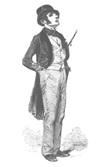Katherine Hayles has an interesting and thought-provoking
article on how we read in today’s world of the ubiquitous screen.
The first point I felt worth noting was the fact the
Professor Hayles published her article on her own website, but via Scribd. Depending on your device and configuration, this
initially means the dreaded scroll bar within a scroll bar, which a lot
of unmotivated would surf away from instantly. The presentation is also clearly
print-like pages, thus suggesting that Professor Hayles prefers printed
material herself.
 |
| The Dreaded Double Scroll Bar |
In the debate of print versus digital, deep versus
skim/scan, she openly comes down on the side of deep reading traditionally
associated with print.
When I can, I print, (though an ecologist at heart),
sometimes to give my eyes a screen break I will shed a few leaves of (hopefully
sustainable) forest. Also, you can scribble notes, underline, or
even highlight if you have the fancy pens. All of which describes the deep
reading many of us have been brought up on, the loss of which many lament, and
not just among academia. Parents of a certain age, frequently regret the loss
of such skills among their screen-addicted teen offspring. Professor Hayles
also notes how digital reading, skimming and scanning, establishes different
brain pathways when compared to print and deep reading.
The essential
difference as I see it, is when we read digitally we are often in a hurry, and
it is this rushing which is contrary to deep reading (sitting somewhere quiet
giving a poem/slice of text your entire
attention), truly attempting to connect to all the writer had in mind, plus of
course the multiple layers of linguistic artistry binding those layers of
meaning. Apparently, research (the results of which the professor calls into
question) has been done on brain activity of various groups while reading
digitally. An interesting study might be a comparison of heart rate while
reading print versus digital. Studies have found that we absorb more, the more
relaxed we are. If we rush when reading digitally, we are not relaxed,
therefore absorbing less? Or perhaps feeling less? That is, not fully
empathizing with the message or messenger?
Skapinke (2015) in a recent Financial Times article cites
research by Mangen and Kuiken (2014) which compares print versus digital when
reading fiction and non-fiction.
Results indicated that,
independently of prior experience with reading on electronic media, readers in
the iPad reported dislocation within the text and awkwardness in handling their
medium. Also, iPad readers who believed they were reading non-fiction were less
likely to report narrative coherence and transportation, while booklet readers
who believed they were reading non-fiction were, if anything, more likely to
report narrative coherence. Finally, booklet (but not iPad) readers were more
likely to report a close association between transportation and empathy.
When measuring how long screen reading has been around
compared to print, (the latter about 5,000 years), Skapinke describes the former
as “a just-peeled-the-protective-plastic-off novelty”.
The fact is screen reading is now natural for many below a
certain age, and there is no way to put that genie back in the box.
 |
| Reading is "cool" on-screen |
According to the National Literacy Trust, boys think it is cool to read on-screen.
If we want younger generations to learn how to read deeply,
as Professor Hayles, and many others do, then we must find ways to adapt our
teaching to integrate the screen. Alan Liu in the English department at the
University of California, Santa Barbara, has been teaching what he calls a
Literature+ course, an example of which is rewiring Shakespeare’s Romeo and
Juliet into “Romeo and Juliet: A Facebook Tragedy”. Thus a form which is
familiar to the students is used to present the age old theme of love and
tragedy in a way that contemporizes it for them, and hopefully develops their
capacity as readers of text, and indeed life.
References
References
Hayles, N. (2010). "How
We Read: Close, Hyper, Machine". Nkhayles.com.
Retrieved 10 December 2015, from http://nkhayles.com/how_we_read.html
Skapinke, M. Those
headed for the top add print to their digital reading. (2015). Retrieved from: http://www.ft.com/cms/s/0/97b30e60-249a-11e5-bd83-71cb60e8f08c.html#axzz3o9uEkSam
Mangen, A. &
Kuiken, D. (2014). Lost in the iPad: Narrative engagement on paper and tablet. Retrieved
from: http://www.academia.edu/9002863/Mangen_A._and_Kuiken_D._2014_._Lost_in_the_iPad_Narrative_engagement_on_paper_and_tablet
Telegraph.co.uk,. (2015). Ebooks boost boys' reading abilities, research
finds. Retrieved 10 December 2015, from http://www.telegraph.co.uk/news/science/science-news/12040488/Ebooks-boost-boys-reading-abilities-research-finds.html
Literacytrust.org.uk,. (2015). Our
research shows using ebooks increases boys’ reading progress and makes them keener,
more confident readers. Retrieved 10 December 2015, from http://www.literacytrust.org.uk/news/6974_our_research_shows_using_ebooks_increases_boys_reading_progress_and_makes_them_keener_more_confident_readers









